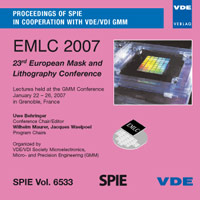Surface chemistry of Ru: relevance to optics lifetime in EUVL
Konferenz: EMLC 2007 - 23rd European Mask and Lithography Conference
22.01.2007 - 26.01.2007 in Grenoble, France
Tagungsband: EMLC 2007
Seiten: 12Sprache: EnglischTyp: PDF
Persönliche VDE-Mitglieder erhalten auf diesen Artikel 10% Rabatt
Autoren:
Wasielewski, R.; Yakshinskiy, B. V.; Hedhili, M. N.; Ciszewski, A.; Madey, T. E. (Dept. of Physics and Astronomy and Laboratory for Surface Modification, Rutgers, The State University of New Jersey, Piscataway NJ 08854)
Inhalt:
Ruthenium capping layers ~2 nm thick are used to protect and extend the lifetimes of Si/Mo multilayer mirrors used in extreme ultraviolet lithography (EUVL) applications. In the present work, we use ultrahigh vacuum surface science methods to address two aspects of Ru surface chemistry: (a) use of atomic hydrogen to remove oxygen from O-covered Ru, and (b) the effects of a model background hydrocarbon gas (methyl methacrylate, MMA) on the accumulation of carbon on a Ru(10i0) single crystal surface. Atomic H is very effective in removing O from Ru even at 300K; the interpretation is that H reacts directly with adsorbed O to make OH, and a subsequent H atom reacts with OH to make H2O, which desorbs at 300K. MMA adsorbs strongly on Ru in the first monolayer and dissociates upon heating; H2 and CO desorption products are seen upon heating from 300 to 600K, while a fractional monolayer of C remains on the surface. Physisorbed multilayers of MMA form at temperatures below ~170K. Thermal desorption of MMA dosed onto O-covered Ru shows that MMA reacts and completely removes an adsorbed O monolayer upon heating. Electron bombardment of MMA/Ru causes polymerization and also can induce accumulation of carbon - all depends on electron fluence, partial pressure of MMA, and substrate temperature.


